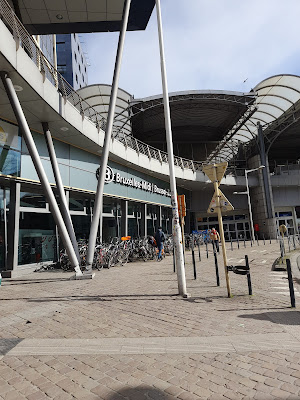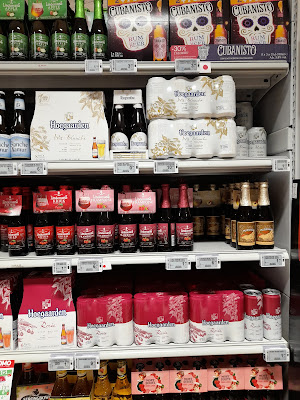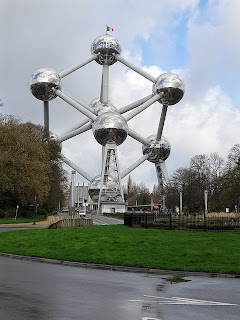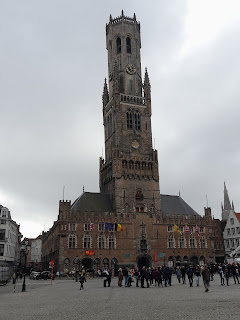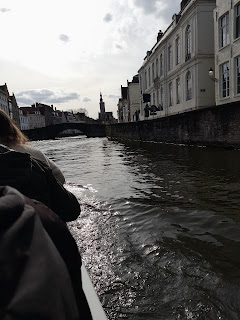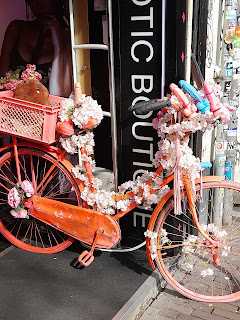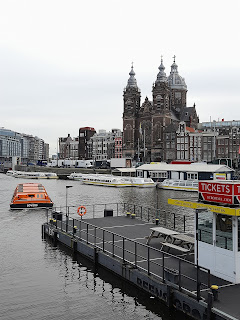After a much needed break we decided to check out Brussels. We took an early flight out with Ryanair. As you all know by now I'm a very anxious flier but all went well, although on reaching Charleroi airport there was light turbulence 😀
From the airport we took the flibco bus to Midi and then the uber to our airbnb. Petruta was waiting for us with the keys and gave us a very warm welcome.
Next we went shopping for food and came back to eat which by now was a very late lunch/dinner as we hadn't eaten anything since 6am. Rafa of course was in his element with all the variety of beer 😉
Enjoy our 1st day photos.
The Sint-Lambertuskerk, also known as the Church of Saint Lambert, is a historic church located in Brussels, Belgium. It is dedicated to Saint Lambert of Maastricht, a medieval bishop and martyr. The church has a rich history dating back to the Middle Ages, although the current building largely dates from the 18th century, with some parts possibly older.
The Sint-Lambertuskerk features a typical Baroque architectural style, characterized by ornate decorations, curved forms, and elaborate details. It serves as both a place of worship and a cultural landmark, attracting visitors with its beautiful interior and historical significance.
The Notre Dame du Sablon Church, located in Brussels, Belgium, is a renowned example of Brabantine Gothic architecture. Built between the 15th and 17th centuries, it stands as a testament to the city's rich cultural and religious history. The church is dedicated to the Virgin Mary and is also known as the Church of Our Blessed Lady of the Sablon.
Notre Dame du Sablon is celebrated for its intricate stone carvings, towering spires, and impressive stained glass windows, which draw visitors from around the world. The church's interior is adorned with magnificent works of art, including sculptures, paintings, and altarpieces, reflecting the skill and craftsmanship of renowned artists throughout the centuries.
The Grand Place, also known as Grote Markt, is the central square of Brussels, Belgium, and one of the most iconic landmarks in the city. Renowned for its stunning architecture, historical significance, and vibrant atmosphere, the Grand Place is a UNESCO World Heritage Site and a must-visit destination for tourists.
Surrounded by elegant guildhalls, the Town Hall, and the King's House (Maison du Roi), the Grand Place is a breathtaking display of medieval and Baroque architecture. The intricate facades of the guildhalls feature ornate decorations, gilded statues, and impressive architectural details that showcase the wealth and power of Brussels during the Renaissance period.
Chocolates everywhere!😋
In Brussels, as well as throughout Belgium, frites (French fries) are not just a beloved food but also a cultural icon. Belgian frites are known for their crispy exterior and fluffy interior, achieved through a unique double-frying process. They are typically served hot, often with a variety of sauces such as mayonnaise, ketchup, and various specialty sauces like samurai sauce or Andalouse sauce.
Brussels boasts numerous friteries (fry shops) where locals and tourists alike can indulge in this delicious snack. Some friteries have become famous for their quality and authenticity, drawing long lines of eager customers.
Frites are deeply ingrained in Belgian culinary tradition and are enjoyed on many occasions, from casual street food to more upscale dining experiences. They are often served alongside other Belgian specialties like moules-frites (mussels and fries) or stoofvlees-friet (beef stew and fries).
Souvenir mannekin pis everywhere too😁
"Janneke Pis" is indeed another statue in Brussels, located not far from its more famous counterpart, the Manneken Pis. Janneke Pis translates to "Little Janneke Pee" in Dutch. Similar to the Manneken Pis, it is a small bronze statue depicting a girl urinating.
Janneke Pis is less well-known and less frequently visited compared to the Manneken Pis, but it still holds a certain charm and interest for tourists exploring Brussels. Like its counterpart, Janneke Pis has also been the subject of various interpretations and legends, contributing to the city's playful and whimsical atmosphere.
While not as iconic as the Manneken Pis, Janneke Pis adds to the quirky character of Brussels and serves as a lesser-known but still intriguing symbol of the city's cultural heritage.
Breweries are also found around every corner 🍺🍻
The Delirium Café is a famous and iconic establishment located in Brussels, Belgium. Renowned for its extensive beer selection, it has earned a reputation as a must-visit destination for beer enthusiasts from around the world.
What sets the Delirium Café apart is its staggering variety of beers, offering over 2,000 different types from around the globe, including Belgian Trappist ales, lambics, IPAs, stouts, and many more. The café's beer menu is so extensive that it has been recognized by the Guinness World Records for having the most varieties of beer commercially available in one place.
Located in the historic center of Brussels, near the Grand Place, the Delirium Café occupies multiple interconnected buildings, each with its own distinct ambiance and character. Its vibrant and bustling atmosphere, along with its eclectic décor adorned with beer memorabilia and paraphernalia, adds to the unique experience of visiting this renowned establishment.

The Mont des Arts, or "Hill of the Arts," is a cultural complex and public space located in the historic center of Brussels, Belgium. Situated between the Place Royale and the Place de l'Albertine, it offers stunning views of the city and is home to several prominent museums, libraries, and cultural institutions.
Originally conceived in the late 19th century as part of an urban renewal project, the Mont des Arts underwent significant development in the 20th century, culminating in its current layout, which features beautifully landscaped gardens, terraces, and architectural landmarks.
Among the notable attractions at the Mont des Arts are:
- The Royal Library of Belgium (also known as the Albertine Library), which houses extensive collections of books, manuscripts, and documents.
- The Royal Museums of Fine Arts of Belgium, comprising the Museum of Ancient Art and the Museum of Modern Art, showcasing a rich and diverse collection of artworks spanning various periods and styles.
- The BELvue Museum, dedicated to the history of Belgium, offering interactive exhibits and multimedia presentations.
- The Musical Instruments Museum (MIM), displaying a vast collection of musical instruments from around the world.
- The Coudenberg Palace archaeological site, where visitors can explore the remains of a medieval palace hidden beneath the streets of Brussels.
In addition to its cultural attractions, the Mont des Arts serves as a popular gathering place for locals and tourists, providing a tranquil oasis amidst the bustling city center. Its panoramic views, lush greenery, and architectural splendor make it a favorite spot for leisurely strolls, picnics, and photography.
Bruges, also known as Brugge in Dutch, is a picturesque medieval city located in the northwest of Belgium. Renowned for its well-preserved medieval architecture, cobbled streets, and winding canals, Bruges is often referred to as the "Venice of the North" due to its resemblance to the Italian city.
Key features and attractions of Bruges include:
Historic City Center: The heart of Bruges is its historic city center, which has been designated as a UNESCO World Heritage Site. Here, visitors can admire stunning medieval architecture, including the Belfry of Bruges, the Basilica of the Holy Blood, and the Markt square.
Canals: Bruges is crisscrossed by a network of canals, which are lined with charming buildings and connected by picturesque bridges. Boat tours offer a unique perspective of the city's architecture and provide insight into its history.
Chocolate and Lace: Bruges is famous for its chocolate shops, offering a wide variety of handmade chocolates and pralines. Additionally, the city is renowned for its lace-making tradition, with several shops selling intricate lace products.
Museums: Bruges is home to several museums, including the Groeningemuseum, which showcases Flemish and Belgian art, and the Historium Brugge, which offers interactive exhibits exploring the city's medieval past.
Markt Square: The Markt square is the central square of Bruges and is surrounded by colorful facades, outdoor cafes, and horse-drawn carriages. It is a lively hub of activity and a popular gathering place for locals and tourists alike.
Beer Culture: Belgium is famous for its beer, and Bruges is no exception. The city boasts numerous pubs and breweries where visitors can sample a wide variety of Belgian beers, including Trappist ales, lambics, and abbey beers.
Our first stop was at Mamma Pancake
Obviousely we left our mark here!
The Beer Wall, also known as the Beer Wall Brugge, is a popular attraction located in Bruges, Belgium. It is a unique beer shop and museum dedicated to Belgian beer culture.
Key features of the Beer Wall include:
Extensive Beer Collection: The Beer Wall boasts an impressive collection of over 1,000 different types of Belgian beers, making it one of the largest selections in Bruges. Visitors can browse through a wide variety of local and international beers, including Trappist ales, lambics, blondes, dubbels, and tripels.
Decor and Atmosphere: The Beer Wall is housed in a historic building with charming interior decor that adds to its cozy and inviting atmosphere. The walls are adorned with beer-related memorabilia, vintage advertisements, and beer bottles from different breweries, creating a unique ambiance for visitors to enjoy.
Tasting Room: The Beer Wall features a tasting room where visitors can sample a selection of Belgian beers in a relaxed setting. Knowledgeable staff are on hand to provide recommendations and insights into the different beer styles and brewing traditions.
Beer Museum: In addition to its beer shop and tasting room, the Beer Wall also houses a small museum dedicated to Belgian beer culture. The museum offers exhibits and displays showcasing the history of brewing in Belgium, as well as the various ingredients, brewing techniques, and beer-related traditions.
Overall, the Beer Wall is a must-visit destination for beer enthusiasts visiting Bruges. Whether you're looking to explore Belgium's rich beer heritage, sample a variety of unique brews, or simply enjoy the cozy atmosphere, the Beer Wall offers a memorable experience for visitors of all backgrounds and interests.
"Torture Museum Oude Steen" or simply the "Torture Museum."
This museum is located in the historic Oude Steen (Old Stone) building, which was once used as a jail. The museum showcases various instruments and devices historically used for torture and punishment throughout Europe, particularly during the medieval period.
Visitors to the Torture Museum can explore exhibits featuring replicas and explanations of medieval torture devices such as the rack, the iron maiden, thumbscrews, and more. The museum provides insights into the darker aspects of European history and the methods employed for judicial and extrajudicial punishment in the past.
While the subject matter may be disturbing for some, the Torture Museum offers a unique opportunity for visitors to learn about the history of justice and punishment in Europe and to reflect on the evolution of societal attitudes toward human rights and dignity.
The Market Square, known as the Markt in Dutch, is the central square of Bruges, Belgium. It is one of the most iconic and bustling areas in the city, offering a vibrant mix of historical landmarks, lively cafes, and colorful architecture.
Key features of the Market Square include:
Belfry of Bruges: The centerpiece of the Market Square is the Belfry of Bruges, a medieval bell tower that dominates the skyline. Visitors can climb the tower for panoramic views of the city and surrounding area.
Provinciaal Hof: Facing the Belfry is the Provinciaal Hof, a neo-Gothic building that once served as the meeting place of the provincial government. It features a stunning facade adorned with statues and intricate carvings.
Markt Square Cafes: The Market Square is surrounded by numerous cafes and restaurants offering outdoor seating, making it a popular spot for locals and tourists to enjoy a meal or drink while taking in the lively atmosphere.
Markt Square Events: Throughout the year, the Market Square hosts various events and festivals, including concerts, markets, and cultural celebrations. These events add to the vibrant energy of the square and attract visitors from near and far.
Architecture: The Market Square is lined with beautiful historic buildings, many of which date back to the medieval period. The architecture reflects the rich history and heritage of Bruges, with styles ranging from Gothic to Renaissance.
The Basilica of the Holy Blood, also known as the Heilig-Bloedbasiliek in Dutch, is a Roman Catholic basilica located in the heart of Bruges, Belgium. It is one of the city's most prominent religious sites and a significant pilgrimage destination for Catholics.
The Basilica of the Holy Blood is renowned for its stunning architecture and its association with a revered relic: a venerated phial said to contain a cloth stained with the blood of Jesus Christ. According to tradition, the relic was brought to Bruges from the Holy Land in the 12th century by Thierry of Alsace, Count of Flanders, after the Second Crusade.
The basilica consists of two chapels: the lower chapel, dedicated to St. Basil the Great, and the upper chapel, dedicated to the Holy Blood. The lower chapel features Romanesque architecture, while the upper chapel is adorned with Gothic elements and magnificent stained glass windows.
One of the highlights of the Basilica of the Holy Blood is the annual Procession of the Holy Blood, which takes place in Bruges every Ascension Day. During the procession, the relic of the Holy Blood is paraded through the streets of the city, attracting thousands of pilgrims and spectators.
The boat tours are a must!
The Jan Breydel Stadium is a prominent sports venue located in Bruges, Belgium. It serves as the home stadium for two of Belgium's top football clubs: Club Brugge KV and Cercle Brugge K.S.V. The stadium is named after Jan Breydel, a historical figure from Bruges who played a significant role in the Battle of the Golden Spurs in 1302.
Curious note, we went through the cemetary to go to the stadium 😎
Amsterdam, the capital city of the Netherlands, is renowned for its picturesque canals, historic architecture, and vibrant cultural scene. Situated in the western part of the country, Amsterdam is characterized by its unique blend of old-world charm and modern innovation.
Key features of Amsterdam include:
Canals: The city is famous for its UNESCO-listed canal ring, which dates back to the 17th century. The canals, lined with elegant merchant houses and adorned with picturesque bridges, are a defining feature of Amsterdam's landscape.
Museums: Amsterdam is home to a wealth of world-class museums, including the Rijksmuseum, which showcases Dutch Golden Age masterpieces, the Van Gogh Museum, dedicated to the works of Vincent van Gogh, and the Anne Frank House, where Anne Frank and her family hid during World War II.
Cycling Culture: Amsterdam is known as one of the most bike-friendly cities in the world, with an extensive network of bike lanes and dedicated cycling infrastructure. Biking is a popular mode of transportation for both locals and visitors alike.
Architecture: The city boasts a rich architectural heritage, with landmarks such as the Royal Palace on Dam Square, the Westerkerk church, and the iconic houses along the canal belt, exemplifying a variety of architectural styles, including Dutch Renaissance and Dutch Golden Age.
Cultural Diversity: Amsterdam is a melting pot of cultures, with residents hailing from all corners of the globe. This diversity is reflected in the city's culinary scene, with a wide array of international cuisines available, as well as in its vibrant arts and music scene.
Naturally in the cold I needed a nice English tea 😀
This is what an enormous salmon pancake looks like in Amsterdam 😋
A full English breakfast to warm up our tummies 😋
and naturally bycicles everywhere
Dam Square is one of the most well-known and central locations in Amsterdam, the capital city of the Netherlands. It's historically significant and serves as a major hub for tourists and locals alike. Here are some key features and aspects of Dam Square:
Historical Significance: The square derives its name from its original function as a dam on the Amstel River, which was built in the 13th century to control the water levels and aid in defense. Over time, it evolved into a bustling marketplace and the heart of the city.
Royal Palace: Dominating one side of the square is the Royal Palace of Amsterdam (Koninklijk Paleis Amsterdam). Originally built as the city hall during the Dutch Golden Age, it became a royal residence in the 19th century. Today, the palace is often used for official ceremonies and is open to the public for tours.
National Monument: In the center of Dam Square stands the National Monument (Nationaal Monument), which was erected in 1956 to memorialize the victims of World War II. It serves as a poignant reminder of the city's history and the sacrifices made during the war.
Madame Tussauds in Amsterdam is part of the renowned chain of wax museums founded by Marie Tussaud. Located in the heart of Amsterdam, near Dam Square, the museum features lifelike wax figures of celebrities, historical figures, politicians, sports icons, and cultural personalities.
Visitors to Madame Tussauds Amsterdam can expect to see a diverse range of figures, including Dutch icons such as Anne Frank and Vincent van Gogh, as well as international stars like Beyoncé, Brad Pitt, and Albert Einstein. The museum often updates its collection to reflect current cultural trends and events, ensuring that there's always something new to see.
One of the highlights of Madame Tussauds Amsterdam is the interactive nature of the exhibits. Visitors can take selfies with their favorite figures, strike a pose alongside famous athletes, or even participate in immersive experiences such as a virtual reality roller coaster ride.
oh and the liquorice!
The Red Light District in Amsterdam is a famous area known for its legalized prostitution, sex shops, and adult entertainment venues. It's located in the oldest part of the city, in the De Wallen neighborhood, which is just a short walk from the central train station. Here are some key aspects of the Red Light District:
Prostitution: Prostitution is legal and regulated in the Netherlands, and Amsterdam's Red Light District is perhaps its most well-known manifestation. Sex workers, mostly women, advertise their services from behind windows illuminated with red lights, hence the name. The area attracts tourists from around the world who come to observe or engage in this aspect of Amsterdam's nightlife.
Cafes and Bars: Alongside the brothels, the Red Light District is filled with cafes, bars, and restaurants, making it a popular nightlife destination for both locals and tourists. It's not uncommon to find people strolling through the area, enjoying drinks, and soaking in the atmosphere.
Erotic Museums and Shops: The Red Light District is also home to several erotic museums and shops, offering a variety of adult-themed items and exhibits. These establishments cater to the curious and adventurous visitors interested in exploring the more risqué side of Amsterdam's culture.
Safety and Regulation: Despite its reputation, the Red Light District is generally safe to visit, especially in the central areas with heavy tourist traffic. The area is also heavily regulated, with laws in place to protect the rights and safety of sex workers. However, visitors should still exercise caution and respect the privacy and boundaries of those working in the district.
Cultural and Historical Significance: Beyond its reputation for adult entertainment, the Red Light District is also a part of Amsterdam's rich cultural and historical tapestry. It's situated in one of the oldest parts of the city, with narrow streets and historic buildings that add to its charm and appeal.
Amsterdam Central Station (Amsterdam Centraal) is the main railway station in Amsterdam and one of the busiest transportation hubs in the Netherlands. Here are some key aspects and features of Amsterdam Central Station:
Location: Amsterdam Central Station is situated in the heart of the city, adjacent to the historic city center and overlooking the IJ waterfront. Its central location makes it easily accessible from various parts of Amsterdam and serves as a gateway to the rest of the country and Europe.
Architecture: The station building itself is an impressive architectural landmark, characterized by its neo-Renaissance style with a distinctive clock tower and ornate facade. Designed by the Dutch architect Pierre Cuypers, who also designed the Rijksmuseum, the station's architecture reflects the grandeur of late 19th-century railway stations.
Transportation Hub: Amsterdam Central Station is not only a railway station but also a major transportation hub, serving as a nexus for trains, trams, buses, and ferries. It connects various regional and international train services, including high-speed trains to cities like Brussels and Paris.
Facilities: The station offers a wide range of facilities and amenities for travelers, including ticket counters, information desks, shops, restaurants, cafes, and luggage storage services. There are also platforms for both domestic and international train services.
Bicycle Parking: Given Amsterdam's reputation as a bike-friendly city, Amsterdam Central Station provides extensive bicycle parking facilities to accommodate the thousands of cyclists who commute to and from the station daily. The station's bike parking facilities include both indoor and outdoor areas.
Waterfront Access: Amsterdam Central Station offers access to the IJ waterfront, where ferries depart for various destinations, including Amsterdam North (Amsterdam-Noord) and other parts of the city. It's also possible to take scenic boat tours departing from nearby piers.
Surrounding Area: The area around Amsterdam Central Station is bustling with activity, featuring a mix of historic buildings, modern architecture, shops, restaurants, and cultural attractions. It's within walking distance of popular landmarks such as Dam Square, the Red Light District, and the Anne Frank House.
Heineken beer is one of the most well-known and widely consumed brands of beer worldwide. Here are some key points about Heineken:
History: Heineken was founded in 1864 by Gerard Adriaan Heineken in Amsterdam, Netherlands. Over the years, it has grown from a small brewery to become one of the largest and most recognizable beer brands globally.
Brewing Process: Heineken beer is brewed using traditional methods, including a mix of malted barley, hops, water, and yeast. It is known for its signature green bottle and distinctive flavor profile, which is characterized by a balanced taste with a slight hop bitterness and a crisp finish.
Global Reach: Heineken is distributed in over 190 countries and territories around the world. It is produced in numerous breweries located in different countries, allowing it to be readily available in a wide range of markets.
Varieties: In addition to its flagship Heineken Lager Beer, the brand offers various other beer styles and products. This includes Heineken 0.0, a non-alcoholic beer, as well as special editions and collaborations with other brands.
Marketing and Sponsorship: Heineken is known for its extensive marketing campaigns and sponsorship activities. It has been involved in sports sponsorships, music festivals, and cultural events, further increasing its visibility and brand recognition.
Sustainability: Heineken has made commitments to sustainability and environmental responsibility. This includes initiatives to reduce water usage, energy consumption, and carbon emissions in its brewing processes, as well as efforts to promote responsible drinking.
Cultural Icon: Heineken has become a cultural icon and is often associated with socializing, relaxation, and enjoyment. It is commonly served in bars, restaurants, and social gatherings worldwide, where it is enjoyed by millions of people.





